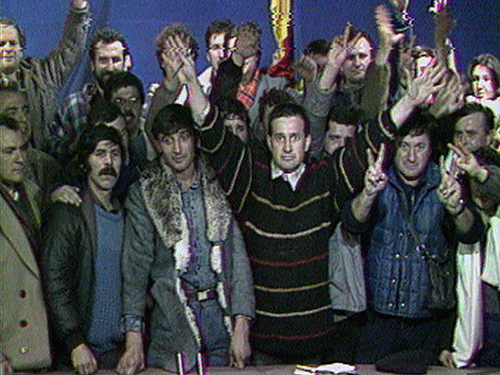
In Europe in the fall of 1989, history took place before our very eyes. Farocki and Ujica's Videograms shows the Rumanian revolution of December 1989 in Bucharest in a new media-based form of historiography. Demonstrators occupied the television station [in Bucharest] and broadcast continuously for 120 hours, thereby establishing the television studio as a new historical site. Between December 21, 1989 (the day of Ceaucescu's last speech) and December 26, 1989 (the first televised summary of his trial), the cameras recorded events at the most important locations in Bucharest, almost without exception.
Dietrich Leder
“From the window of a student dormitory in Timişoara an amateur video camera records demonstrators moving towards the center of the city.”
Narrator of Videograms of a Revolution
“The actors in the revolution and the operators of the media apparatuses appear on two sides, both as spectators and as the creators of the spectacle. Contrary to the expectations that the film should show the mechanisms behind the stage, Videograms dwells on the moment when nearly everything is still undetermined, exposing the situation of pure contingency and havoc. It shows how the development of the events can be aligned with the operation of cameras. The act of recording triggers certain behaviour in participants of the recorded scene, while on the other hand the images produced and quickly disseminated through television impact the viewers and instantly create televised facts. The contradiction between spontaneity and staging thus becomes apparent. In that sense, the strange doubling of the revolutionary call – first from below, from Rodica Marcau, representing the revolting masses, the second one from above, from the still all-powerful authority personified by Ceauşescu – brings to light this multifaceted transformation in all the complexity of its unfolding.”
Katarzyna Ruchel-Stockmans1
“Aan de hand van televisiebeelden en found footage onderzochten Farocki en Ujică de twijfelachtige verslaggeving van de Roemeense revolutie van 1989. De volksopstand en val van het regime van Ceaușescu leken zich live op televisie te voltrekken, maar algauw bleek dat verschillende beelden in scène waren gezet. De directe aanleiding voor de revolutie, de massamoord op demonstranten in Timisoara, bleek niet eens te hebben plaatsgevonden. ‘Waarheid’ werd als criterium vervangen door ‘geloofwaardigheid’, stelt Ruchel-Stockmans in dit verband. Voor Jean Baudrillard en Giorgio Agamben maakten de gebeurtenissen de waarheidsclaim van fotografie onhoudbaar. Farocki en Ujică stelden het medium zelf ter discussie. Met Videograms of a Revolution wilden zij de hypothese van Flusser testen: in hoeverre zijn de beelden op te vatten als een registratie van de gebeurtenissen en in hoeverre hebben ze die gebeurtenissen zelf tot stand gebracht? De actualiteit van dit werk is bijna beangstigend, met het oog op het trumpiaanse post-truth tijdperk, en de rol van burgerjournalistiek en sociale media in de verslaggeving en bevordering van de Arabische Lente.”
Anne Ruygt2
“Andrei Ujica: Harun Farocki contacted me through the publishing house, expressing his interest in making a film adaptation of the dialogues and asking me if I wanted to help him. I told him it would be so much more interesting to make a film about what is not dealt with in the book, namely the videograms of that revolution. We decided to do it together. The idea at the basis of the project can be summarized in this way: in 1989, a hundred cameras followed what was happening in Romania; history is no longer divided into theatrical scenes, nor into literary chapters—it is perceived as a sequence; and the sequence demands a film.
Rob White: One of the narrator’s main theoretical statements in Videograms of a Revolution is: “Since its invention, film has seemed destined to make history visible. It has been able to portray the past and to stage the present. We have seen Napoleon on horseback and Lenin on the train. Film was possible because there was history. Almost imperceptibly, like moving forward on a Möbius strip, the side was flipped. We look on and have to think: if film is possible then history too is possible.” Are you a historian?
Inherently, any artist who transcribes his historical biography into his work is also a historian. [...]
The prevailing artistic medium of an age has always had a determining influence on history. This is clearly the case in the Modern European Age. It has been influenced by theater, from Shakespeare to Schiller, and then by the novel, until Tolstoy. We know that the twentieth century is filmic. But it is only with the advent of the video camera, and the increased possibilities for lengthy and mobile recording it offers, that the process of the filmification of history can be completed.”
Rob White in conversation with Andrei Ujica3
- 1Katarzyna Ruchel-Stockmans, Images Performing History: Photography and Representatons of the Past in European Art After 1989, Leuven: University Press, 2015.
- 2Anne Ruygt, ‘De geschiedenis herzien. “Images Performing History. Photography and Representations of the Past in European Art After 1989” van Katarzyna Ruchel-Stockmans’, De Witte Raaf, November 2018.
- 3Rob White, “Interview with Andrei Ujica,” Film Quarterly, Spring 2011.

